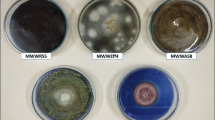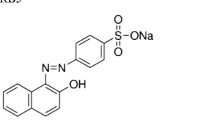Abstract
The nutritional conditions supporting growth and maximum dye removal by Aspergillus lentulus have been investigated. Initially a composite media containing yeast extract, glucose and mineral components was used and the effect of various components on dye removal was studied. For maximum dye removal (≈100%), ≥0.5% (w/v) glucose and ≥0.25% (w/v) yeast extract were essential. While glucose played an important role in pellet formation, which in turn was important for dye removal, yeast extract contributed towards higher biomass production. Mineral components (except NH4NO3) did not affect dye removal significantly. Next the alternate sources of carbon (molasses, jaggery, starch and sodium acetate) and nitrogen (peptone, urea, ammonium nitrate, sodium nitrate and ammonium chloride) were tested. Among carbon sources, all the sources produced almost complete dye removal in 48 h (more than 97% in 24 h), except sodium acetate (64% in 48 h). All the tested nitrogen sources resulted in >90% dye removal in 48 h. Yeast extract and peptone gave best results with high dye removal rate (9.8 and 8.1 mg/l/h, respectively). However, among the low cost alternates, urea and NH4Cl came out to be suitable sources due to the high uptake capacity of the biomass produced coupled with high dye removal rate in case of NH4Cl. Therefore, a combination of urea and NH4Cl was tested, which produced complete dye removal with a high dye removal rate (10 mg/l/h). Finally the modified composite media containing urea and NH4Cl as nitrogen sources and glucose as carbon source was utilized for effluent treatment. Results indicated that performance of modified composite media was at par with composite media for supporting growth of A. lentulus and dye removal from the textile effluent.









Similar content being viewed by others
References
Assadi MM, Rostami K, Shahvali M, Azin M (2001) Decolorization of textile wastewater by Phanerochaete chrysosporium. Desalination 141:331–336
Fu Y, Viraraghavan T (2001) Fungal decolourization of dye wastewaters: a review. Bioresour Technol 79:251–262
Hatvani N, Mecs I (2002) Effect of the nutrient composition on dye decolourisation and extracellular enzyme production by Lentinus edodes on solid medium. Enzyme Microb Technol 30:381–386
Joshi M, Bansal R, Purwar R (2004) Colour removal from textile effluents. Indian J Fiber Textile Res 29:239–259
Kapdan IK, Kargia F, McMullanb G, Marchant R (2000) Effect of environmental conditions on biological decolourization of textile dyestuff by C. versicolor. Enzyme Microb Technol 26:381–387
Kaushik P, Malik A (2009a) Fungal dye decolourization: recent advances and future potential. Environ Int 35:127–141
Kaushik P, Malik A (2009b) Microbial decolourization of textile dyes through isolates obtained from contaminated sites. J Sci Ind Res 68:325–331
Liao W, Liu Y, Frear C, Chen S (2007) A new approach of pellet formation of a filamentous fungus—Rhizopus oryzae. Bioresour Technol 98:3415–3423
Liu GF, Zhou JT, Wang J, Song ZY, Qv YY (2006) Bacterial decolorization of azo dyes by Rhodopseudomonas palustris. World J Microbiol Biotechnol 22:1069–1074
Martins MAM, Cardoso MH, Queiroz MJ, Ramalho MT, Campos AMO (1999) Biodegradation of azo dyes by the yeast Candida zeylanoides in batch aerated cultures. Chemosphere 38:2455–2460
Mathur N, Bhatnagar P, Bakre P (2005) Assessing mutagenicity of textile dyes from Pali (Rajasthan) using AMES bioassay. Appl Ecol Environ Res 4:111–118
Miller GL (1959) Use of dinitrosalicylic acid reagent for determination of reducing sugar. Anal Chem 31:426–428
Mohana S, Shrivastava S, Divecha J, Madamwar D (2008) Response surface methodology for optimization of medium for decolorization of textile dye Direct Black 22 by a novel bacterial consortium. Bioresour Technol 99:562–569
Moosvi S, Kher X, Madamwar D (2007) Isolation, characterization and decolorization of textile dyes by a mixed bacterial consortium JW-2. Dyes Pigments 74:723–729
Parshetti GK, Kalme SD, Gomare SS, Govindwar SP (2007) Biodegradation of Reactive Blue-25 by Aspergillus ochraceus NCIM-1146. Bioresour Technol 98:3638–3642
Rigas F, Dritsa V (2006) Decolourisation of a polymeric dye by selected fungal strains in liquid cultures. Enzyme Microb Technol 39:120–124
Robinson T, McMullan G, Marchant R, Nigam P (2001) Remediation of dyes in textile effluent: a critical review on current treatment technologies with a proposed alternative. Bioresour Technol 77:247–255
Sumathi S, Manju BS (2000) Uptake of reactive textile dyes by Aspergillus foetidus. Enzyme Microb Technol 27:347–355
Acknowledgments
Department of Science & Technology, Government of India is gratefully acknowledged for financial assistance.
Author information
Authors and Affiliations
Corresponding author
Rights and permissions
About this article
Cite this article
Kaushik, P., Malik, A. Effect of nutritional conditions on dye removal from textile effluent by Aspergillus lentulus . World J Microbiol Biotechnol 26, 1957–1964 (2010). https://doi.org/10.1007/s11274-010-0376-9
Received:
Accepted:
Published:
Issue Date:
DOI: https://doi.org/10.1007/s11274-010-0376-9




